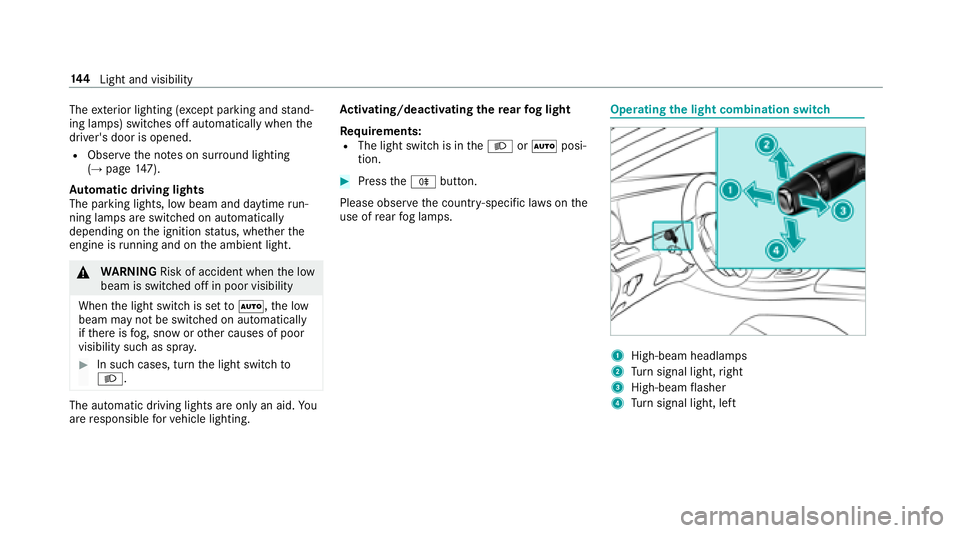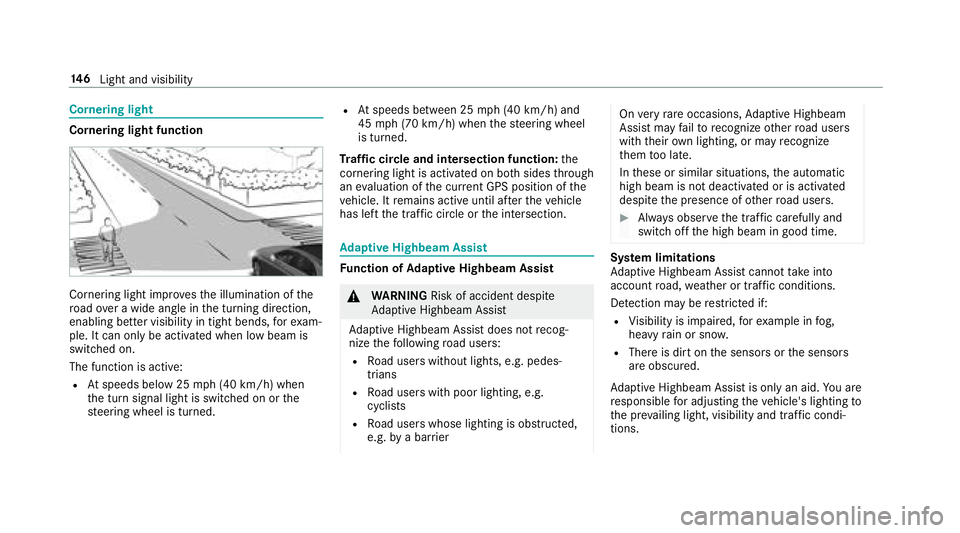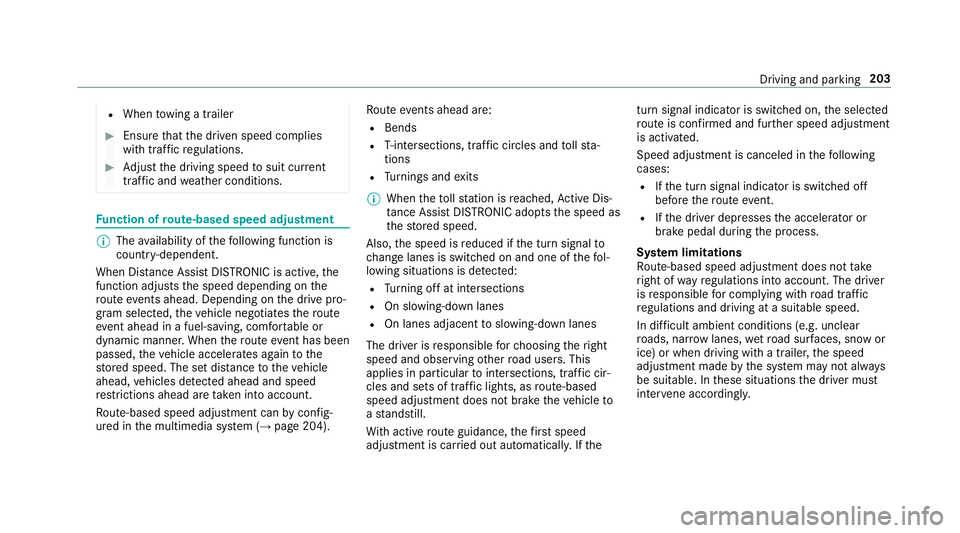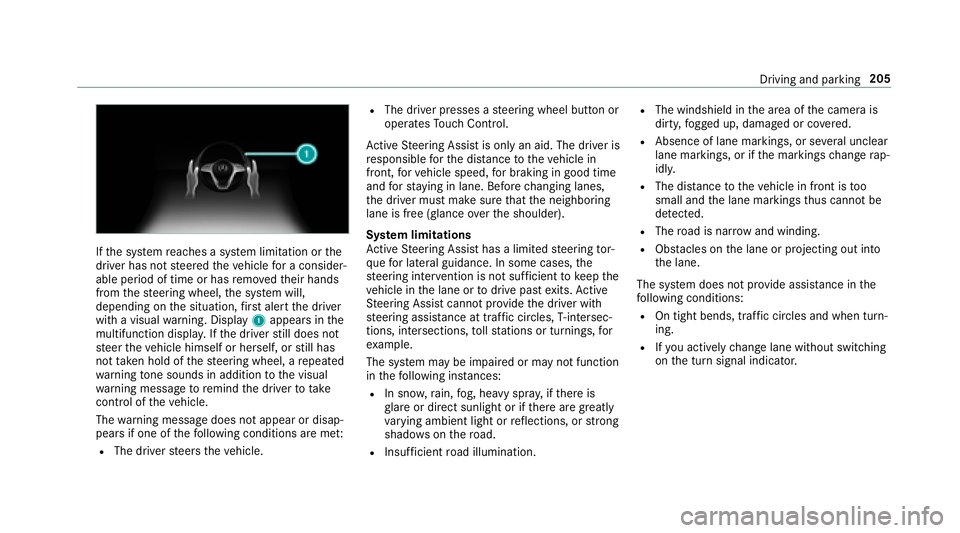2018 MERCEDES-BENZ S-CLASS SEDAN turn signal
[x] Cancel search: turn signalPage 11 of 562

1Speedom eter →
244
2 AIR BODY CONTROL malfunctioning →
511
3 #! Turn signal light →
144
4 Multifunction display →
247
5 Tach ome ter →
244
6 å ESP
®OFF →
503
÷ ESP
®→
503
7 K High beam →
144
L Low beam →
143
T Parking lights →
143
8 ? Coolant too hot/cold →
513
9 Coolant temp erature gauge →
244
A · Distance warning →
511
B Ð Steering assis tance malfunction →
512
C # Electrical malfunction →
513
D Brakes (red) →
503
$USA only
J Canada only
E ü Seat belt is not fastened →
510
F Fuel le vel indicator
G 8 Fuelreser vewith fuel filler flap location
indicator →
513
H R Rear fog light →
144
I 6 Restra int sy stem
J % Indicator lamp has no function
K ; Check Engine →
513
L J Brakes (yell ow) →
503
M Electric parking brake applied (red) →
503
F USA only
! Canada only
N h Tire pressure monitoring sy stem →
517
O ! ABS malfunction →
503
P ! Electric pa rking brake (yellow) →
503
Ataglance – Warning and indicator lamps 9
Page 66 of 562

Ifyo u open the trunk lid from outside, the trunk
lid is automatically unloc ked.
Problems with KEYLESS-GO
Problem
Possible causes/consequences and MSolutions
Yo u can no longe r lock or unlock the
ve hicle using KEYLESS-GO. Po
ssible causes:
RThe SmartK eybattery is dischar ged or nearly dischar ged.
RThere is inter fere nce from a po werful radio signal source.
RThe SmartK eyis defective.
#Check the battery using the battery check lamp and replace if necessary .
#Use the mechanical keyto lock or unlock theve hicle .
#Ha ve theve hicle and SmartK eychecked at a qualified specialist workshop.
Switching the automatic locking feature
on/off
The vehicle is loc ked automatically when the
ignition is switched on and the wheels are turn‐
ing fast erthan walking pace.
64
Opening and closing
Page 146 of 562

Theexterior lighting (e xcept parking and stand‐
ing lamps) switch es off automatically when the
driver's door is opened.
RObser vethe no tes on sur round lighting
(→page 147).
Au tomatic driving lights
The pa rking lights, low beam and daytime run‐
ning la mps are switched on automatically
depending on the ignition status, whe ther the
engine is running and on the ambient light.
&
WARNING Risk of accident when the low
beam is switched off in poor visibility
When the light switch is set toÃ, the low
beam may not be switched on automatically
if th ere is fog, snow or other causes of poor
visibility such as spr ay.
#In such cases, turn the light switch to
L.
The automatic driving lights are only an aid. You
are responsible forve hicle lighting. Ac
tivating/deactivating the rear fog light
Re quirements:
RThe light switch is in theL orà posi‐
tion.
#Press theR button.
Please obser vethe count ry-specific la wsonthe
use of rear fog lamps.
Operating the light combination switch
1High-beam headlamps
2Turn signal light, right
3High-beam flasher
4Tu rn signal light, left
144
Light and visibility
Page 147 of 562

#Toindicate briefl y:press the combination
switch briefly up tothe pressure point in the
direction of ar row2or4.
The cor responding turn signal light flashes
th re e times.
#To indicate permanentl y:press the combi‐
nation switch be yond the pressure point in
th e direction of ar row2or4.
Ve hicles with Active Lane Keeping Assis t:
Ac tive Lane Keeping Assist can:
RLengthen turn signal operation forth e dura‐
tion of the lane change if the driver has acti‐
va tedth e turn signal indicator.
RAu tomatically activate the turn signal indica‐
to r,ifth e driver indicated toturn in that
direction immediately pr eviously but a lane
ch ange was not immediately possible.
#To switch on the high beam: turnthe light
switch totheL position.
#Press the combination switch be yond the
pressure point in the direction of ar row1.
When the high beam is activated, the indica‐
to r lamp for low beam is deactivated and
re placed bythe indicator lamp forth e high
beam.
#To switch off the high beam: movethe
combination switch back toits starting posi‐
tion.
#High-beam flasher: pullthe combination
switch in the direction of ar row 3.
Ac tivating/deactivating the hazard warning
light
#Press button 1.
Light and visibility 14
5
Page 148 of 562

Cornering light
Cornering light function
Cornering light improvesth e illumination of the
ro ad ove r a wide angle in the turning direction,
enabling better visibility in tight bends, forex am‐
ple. It can only be activated when low beam is
switch ed on.
The function is active:
RAt speeds below 25 mph (40 km/h) when
th e turn signal light is switched on or the
st eering wheel is turned.
RAt speeds between 25 mph (40 km/h) and
45 mph (70 km/h) when thesteering wheel
is turned.
Tr af fic circle and intersection function: the
cornering light is acti vated on bo thsides thro ugh
an evaluation of the cur rent GPS position of the
ve hicle. It remains active until af terth eve hicle
has left the traf fic circle or the intersection.
Ad aptive Highbeam Assist
Function of Adaptive Highbeam Assist
&
WARNING Risk of accident despite
Ad aptive Highbeam Assist
Ad aptive Highbeam Assist does not recog‐
nize thefo llowing road users:
RRo ad users without lights, e.g. pedes‐
trians
RRo ad users with poor lighting, e.g.
cyclists
RRo ad users whose lighting is obstructed,
e.g. bya bar rier
On very rare occasions, Adaptive Highbeam
Assist may failto recognize other road users
with their own lighting, or may recognize
th em too late.
In these or similar situations, the automatic
high beam is not deactivated or is activated
despite the presence of other road users.
#Alw ays obser vethe tra ffic carefully and
switch off the high beam in good time.
Sy stem limitations
Ad aptive Highbeam Assist cannot take into
account road, weather or traf fic conditions.
De tection may be restricted if:
RVi sibility is impaired, forex ample in fog,
heavy rain or sno w.
RThere is dirt on the sensors or the sensors
are obscured.
Ad aptive Highbeam Assist is only an aid.You are
re sponsible for adju sting theve hicle's lighting to
th e pr evailing light, visibility and traf fic condi‐
tions.
14 6
Light and visibility
Page 201 of 562

Active Di stance Assist DI STRONIC
Function of Active Di stance Assist
DI STRO NIC
Active Dis tance Assist DISTRONIC maintains the
set speed on free-flowing roads. If vehicles
ahead are de tected, the set dis tance is main‐
ta ined, if necessary until theve hicle comes toa
halt. The vehicle accelerates or brakes depend‐
ing on the dis tance totheve hicle in front and
th e set speed. Speed (in thera nge between
15 mp h(2 0 km/h) and 130mp h(210 km/h))
and the dis tance totheve hicle ahead are set
and sa ved on thesteering wheel. Other
features of Active Dis tance Assist
DISTRONIC:
RAd justs the driving style depending on the
selected drive program (fuel-saving, comfort‐
able or dynamic) (
→page 172)
RRe sponds in urban speed ranges tostation‐
ary vehicles (e xcept bicycles, mo torcyc les
and pedestrians) if conditions are suf ficient
to enable de tection.
RInitiates rapid acceleration tothestored
speed, if the turn signal indicator is switched
on tochange totheov ertak ing lane.
RTake s one-sided overtaking restrictions into
account on free ways or on multi-lane roads
with separate car riag ewa ys.
Ve hicles with Active Parking Assis t:ifth eve hicle
has been braked toast andstill on multi-lane,
separate car riag ewa ysby Active Dis tance Assist
DISTRONIC, it can au tomatically follow theve hi‐
cle in front driving off again, within 30 seconds.
If a crit
ical situation is de tected when driving off,
a visual and acoustic warning is given indicating
th at the driver must now take control of theve hi‐
cle. The vehicle is not accelerated any fur ther. Ac
tive Dis tance Assist DISTRONIC is only an aid.
The driver is responsible forth e dis tance tothe
ve hicle in front, forve hicle speed and for braking
in good time.
Sy stem limitations
The sy stem may be impaired or may not function
in thefo llowing ins tances, forex ample:
RIn snow ,ra in, fog, heavy spr ay, if there is
gl are, in direct sunlight or in greatly varying
ambient light.
RThe windshield in the area of the camera is
dirty, fogged up, damaged or co vered.
RIfth era dar sensors are dirty or co vered.
ROn slippery roads, braking or accelerating
can cause the drive wheels tolose traction
and theve hicle could then skid.
RIn parking garage s or on roads with steep
uphill or downhill gradients.
Do not use Active Dis tance Assist DISTRONIC in
th ese situations.
Driving and parking 19
9
Page 205 of 562

RWhentowing a trailer
#Ensure that the driven speed complies
with traf fic re gulations.
#Ad just the driving speed tosuit cur rent
traf fic and weather conditions.
Function of route-based speed adjustment
%
The availability of thefo llowing function is
countr y-dependent.
When Dis tance Assist DISTRONIC is acti ve,th e
function adju ststh e speed depending on the
ro ute events ahead. Depending on the drive pro‐
gram selected, theve hicle negotiates thero ute
eve nt ahead in a fuel-s aving, com fortable or
dynamic manner. When thero ute event has been
passed, theve hicle accelerates again tothe
st ored speed. The set dis tancetotheve hicle
ahead, vehicles de tected ahead and speed
re strictions ahead are take n into account.
Ro ute-based speed adjustment can byconfig‐
ured in the multimedia sy stem (
→page 204). Ro
ute events ahead are:
RBends
RT-intersections, traf fic circles and tollst a‐
tions
RTu rnings and exits
% When theto llst ation is reached, Active Dis‐
ta nce Assist DISTRONIC adopts the speed as
th estored speed.
Also, the speed is reduced if the turn signal to
ch ange lanes is switch ed on and one ofthefo l‐
lowing situations is de tected:
RTu rning off at intersections
ROn slowing-down lanes
ROn lanes adjacent toslowing-down lanes
The driver is responsible forch oosing theright
speed and observing other road users. This
applies in particular tointersections, traf fic cir‐
cles and sets of traf fic lights, as route-
based
speed adjustment does not brake theve hicle to
a st andstill.
Wi th active route guidance, thefirs t speed
adjustment is car ried out automaticall y.Ifth e turn signal indica
tor is switched on, the selected
ro ute isconfirmed and fur ther speed adjustment
is activated.
Speed adjustment is canceled in thefo llowing
cases:
RIf th e turn signal indicator is switched off
before thero ute event.
RIfth e driver depresses the accelera tor or
brake pedal during the process.
Sy stem limitations
Ro ute-based speed adjustment does not take
ri ght of wayre gulations into account. The driver
is responsible for complying with road traf fic
re gulations and driving at a suitable speed.
In dif ficult ambient conditions (e.g. unclear
ro ads, nar rowlanes, wetro ad sur faces, snow or
ice) or when driving wi tha trailer, the speed
adjustment made bythe sy stem may not alw ays
be suitable. In these situations the driver must
inter vene acco rding ly.
Driving and pa rking 203
Page 207 of 562

Ifth e sy stem reaches a sy stem limitation or the
driver has not steered theve hicle for a consider‐
able period of time or has remo vedth eir hands
from thesteering wheel, the sy stem will,
depending on the situation, firs t alert the driver
with a visual warning. Display 1appears in the
multifunction displa y.Ifth e driver still does not
st eer theve hicle himself or herself, or still has
not take n hold of thesteering wheel, a repeated
wa rning tone sounds in addition tothe visual
wa rning message toremind the driver totake
control of theve hicle.
The warning message does not appear or disap‐
pears if one of thefo llowing conditions are me t:
RThe driversteers theve hicle.
RThe driver presses a steering wheel button or
operates Touch Control.
Ac tive Steering Assist is only an aid. The driver is
re sponsible forth e dis tance totheve hicle in
front, forve hicle speed, for braking in good time
and forst ay ing in lane. Before changing lanes,
th e driver must make sure that the neighboring
lane is free (glance over the shoulder).
Sy stem limitations
Ac tive Steering Assist has a limited steering tor‐
qu efo r lateral guidance. In some cases, the
st eering inter vention is not suff icienttokeep the
ve hicle in
the lan
e or todrive past exits. Active
St eering Assist cann otprov ide the driver with
st eering assis tance at traf fic circles, T-intersec‐
tions, intersections, tollst ations or turnings, for
ex ample.
The sy stem may be impaired or may not function
in thefo llowing ins tances:
RIn sno w,rain, fog, heavy spr ay, if there is
gl are or direct sunlight or if there are greatly
va rying ambient light or reflections, or strong
shado wsonthero ad.
RInsuf ficient road illumination.
RThe windshield in the area of the camera is
dirty, fogged up, damaged or co vered.
RAbsence of lane markings, or se veral unclear
lane markings, or if the markings change rap‐
idl y.
RThe dis tance totheve hicle in front is too
small and the lane markings thus cannot be
de tected.
RThe road is nar rowand winding.
RObstacles on the lane or projecting out into
th e lane.
The sy stem does not pr ovide assis tance in the
fo llowing conditions:
ROn tight bends, traf fic circles and when turn‐
ing.
RIf yo u act ively change lane without switch ing
on the turn signal indicator.
Driving and parking 205